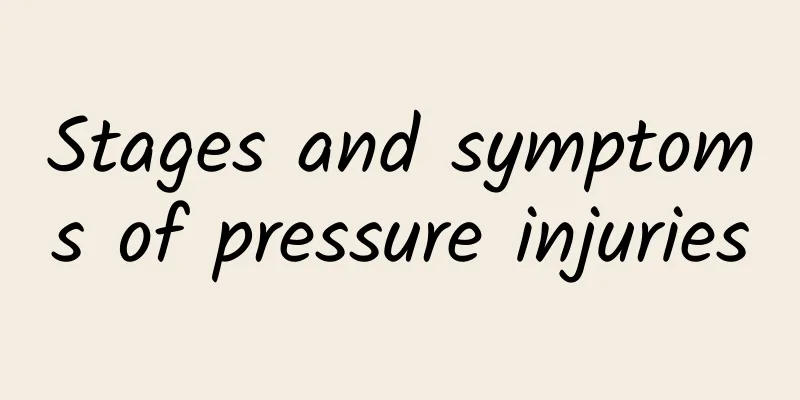Stages and symptoms of pressure injuries

|
Pressure injuries, also known as bedsores or pressure ulcers, are local injuries to the skin and/or subcutaneous soft tissues located over bony prominences, under medical or other devices, and are caused by strong and/or prolonged pressure or pressure combined with shear force. Prolonged pressure causes local blood circulation disorders in the skin and underlying tissues, which in turn causes tissue necrosis. Pressure injuries are common in patients who are bedridden for a long time, in wheelchairs, or whose mobility is limited due to illness. 1. Stages of pressure ulcers Stage 1 pressure injury (pressure sore): At this time, the skin is intact and there is no blanchable red spot when pressed. This is because the local blood circulation has been affected to a certain extent. In addition to color changes, patients may feel pain, temperature rise or fall in the pressure area, which are signals from the skin and underlying tissues under the influence of pressure. The skin condition at this time indicates that if appropriate prevention and intervention measures are not taken, such as changing body position to reduce pressure, using special support cushions or mattresses, and keeping the skin clean and properly moisturized, the skin injury may further develop and enter a more serious stage. Stage 2 pressure injury (pressure sore): Partial skin loss, visible dermis, active, pink or red, moist wound surface, may also appear as serous blisters (intact or broken). It marks the initial destruction of skin integrity. At this time, the damage is not limited to the epidermis, but may also extend to the dermis. At this stage, pressure sores appear as surface abrasions, skin tears or blisters. The wound may reveal the underlying skin tissue, but has not yet affected the subcutaneous fat or deeper tissues. When treating stage 2 pressure injuries (pressure sores), the focus is on keeping the wound clean and dry, using appropriate dressings to absorb wound secretions, and avoiding further pressure and friction to support the natural healing process. Stage 3 pressure injury (pressure sore): Full-thickness skin damage; exposure of fat tissue and granulation tissue is visible, but muscle or bone has not yet been involved. It is characterized by a deeper wound, irregular edges, and the bottom of the wound may be covered with necrotic tissue, which may be yellow, gray, or even black, indicating tissue death. Stage 4 pressure injuries (pressure ulcers) are the most severe stage, with injuries extending deep into muscle, tendon, and even bone. The wound is extremely deep and large, often accompanied by severe necrotic tissue and possible abscess formation. At this stage, wound treatment becomes more complex and challenging, not only because of the severity of the wound itself, but also because of the higher risk of infection and other complications. Deep tissue damage: The skin appears persistently dark red, brown or purple, or the epidermis separates to reveal a dark wound bed or blood-filled blisters. Although the skin appears intact on the surface, there may be purple-black damaged areas hidden under the skin, indicating that the deep tissues have been severely affected. Unstageable: Full-thickness skin and tissue loss, obscuring the extent of the injury. This type of pressure ulcer may not appear to be that severe on the surface, but the underlying tissue damage may be very extensive, complicating accurate assessment of its depth and severity. Necrotic tissue may be firm, skin-colored or black, covering the wound and preventing observation of the actual depth of the wound. Symptoms of Pressure Injury The symptoms of a pressure injury vary depending on the stage of development. In the early stages, the initial symptom may be just redness or darkening of the skin's surface, especially in areas of sustained pressure. This color change is accompanied by an increase or decrease in the skin's temperature, and there may also be a change in how it feels, such as becoming softer or harder. People may report mild pain or discomfort, especially in the area of pressure. As a pressure injury progresses to stage 2, symptoms become more pronounced and include breakdown of the skin, the formation of small blisters, or surface abrasions. There may be further redness or swelling around the wound, and the wound may have exudate. When the pressure injury progresses to stage 3, the wound will go deeper into the subcutaneous tissue. At this time, the patient may see exposed fat layer, the wound edges may be irregular, and there may be necrotic tissue or purulent discharge deep in the wound, which are all signs of infection. The pain may increase, especially when touching or moving the affected area. In stage 4, the symptoms of pressure injury include large areas of injury deep into muscle and bone. The wound may be very deep and large, with severe necrosis. There may be a foul odor. The pain may be very obvious, or the sensation may be reduced due to nerve damage. During all of these stages, the risk of infection increases significantly, manifested by symptoms such as increased warmth, redness, swelling, increased pain, and increased discharge. If not recognized and treated promptly, pressure injuries (pressure ulcers) can lead to more serious complications such as sepsis or chronic pain. Conclusion Pressure injuries (pressure sores) not only cause pain to patients, but also prolong the treatment cycle and increase medical costs. Therefore, understanding the stages and symptoms of pressure injuries is crucial for early identification and prevention. For pressure injuries that have already occurred, appropriate treatment measures should be taken as soon as possible, and the treatment plan should be adjusted according to the specific conditions of the wound. In any case, timely communication with medical professionals and the development of a reasonable care plan are important steps to ensure the health of patients and improve their quality of life. Author: Zhang Bing Hengshui People's Hospital |
<<: Pre-hospital treatment of severed fingers
>>: Know your heart clearly: some basic knowledge about cardiac ultrasound!
Recommend
Taking Yasmin makes menstruation very light
After taking Yasmin, the amount of menstruation d...
I've been in menopause for four years, and it's suddenly back. What's going on?
We understand that as women age, the changes in t...
What precautions should be taken before testing prolactin?
I believe that everyone pays special attention to...
Do I need to take calcium tablets when I am seven months pregnant?
Calcium supplementation is also needed after seve...
This disease is so painful that it has become a hot topic. Should we get the vaccine that costs thousands of yuan?
recently A pain is a warning sign of shingles Bec...
Leg weakness during early pregnancy
Women will have more physical problems during pre...
More than 12 ovarian follicles on both sides
The key to the onset of polycystic ovary syndrome...
How to eat duck intestines? How to identify duck intestines
The weather has been really hot lately, and peopl...
Why does my stomach hurt after sex?
When adult men and women have sex, the woman will...
Can I drink Huadiao wine during my menstrual period?
Huadiao wine is a very common type of wine. This ...
Women with excessive leucorrhea can eat more ginkgo porridge
Reader Ms. Huang asked: I have had the problem of...
Can I drink red bean soup after giving birth? Pay attention to your diet
Because the mother consumes a lot of energy durin...
If you are still infected after vaccination, should you continue to get the vaccine? What are the differences between the four domestic vaccines?
|||| Written by reporter Lai Tianying Edited by D...
Early screening for liver cancer = life-saving opportunity!
China accounts for 45% of new liver cancer cases ...
How to take care of the sugar mother and sugar baby during gestational diabetes
Expert Name: Huang Haiyan Expert introduction: Hu...









